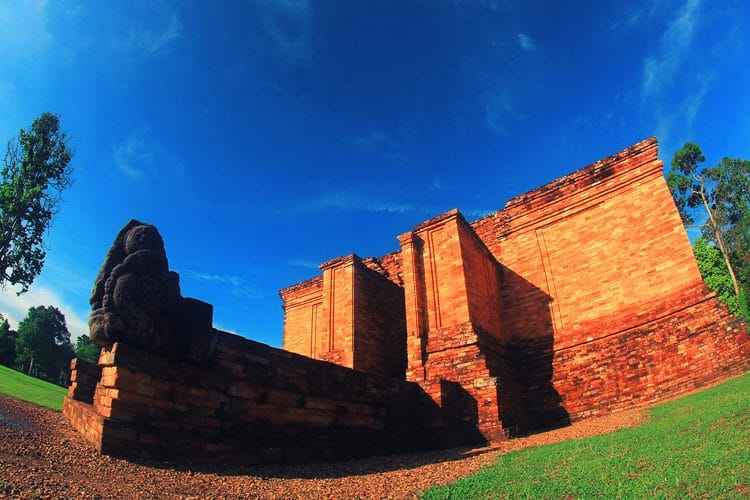Jambi Cultural Heritage
Have any plan to explore Indonesia? Any itinerary have been planned for your traveling to Indonesia? Have you decided which part of Indonesia will you explore? What about exploring Jambi Cultural Heritage in Muara Jambi tourism village, Maro Sebo district, Muaro Jambi regency, Jambi Province?
At Jambi Cultural Heritage area, you will explore the amazing Muarajambi Temple Compound Site. It is about 35 km from the Sultan Thaha airport in Jambi. You can reach The site within 40 minutes by land transportation or one hour through Batanghari River. The site is spread along 7.5 km of the Batanghari riverbanks. Visitors can reach the temple compounds through the old canals or man-made rivers, that connect the Batanghari riverbanks with the Site.
What are The Unique of Jambi Cultural Heritage?
The Historical Value
According to the archeologist findings, the Muarajambi Temple Compound Site that covers an area of 2062 hectares Jambi Cultural Heritage area is a relic of ancient Malay Kingdom. There were at least 82 ruins of ancient Temples made of brick construction.
Eight of 82 Temples have been restored such as Kembarbatu , Gumpung , Tinggi , Gedong I , Gedong II, Kedaton, Koto Mahligai, and Astano. The site was a Buddhist education center functioning during the 7th and 8th centuries. It is also supported by the results of archaeological research about the similarity between the bricks used to build the Muaro Jambi shrine and those making up Buddhist temples in India. Thus has made the Site to become the largest Compound Site in Southeast Asia.
As a part of the restoration process of the Site, the local community also planted Sumatran endemic plants to cover the remaining unrestored structures. In addition, the government and local community were also working together to restore the ancient canals in Jambi River and the Telago Rajo Ponds.
The Outstanding of Universal Value
According to UNESCO, The Muarajambi Temple Compound Site has unique universal value due to its cultural heritage findings and the preserved environment that has been maintained by the local community. UNESCO stated that the building of the temples has reflected the remarkable values of humanities based on the philosophy of Hinduism-Buddhism.
The building has also reflected its technology and architecture development. It reflected how the local people with their wisdom had developed an amazing technique for constructing the temple that fit with the geographical condition. They built canals and the water reservoirs that pass around the temple complex. The canal used for transportation to reach the temple. The water reservoirs helped them to manage their farms for their daily needs.
In terms of the architectural aspect, the local community showed their good knowledge and skill in designing the building structures including in choosing the materials used for constructions.
Example of Itinerary to Explore Jambi Cultural Heritage
If you are interested in exploring Jambi Cultural Heritage, you may consider the following itinerary:
Day – 1
- Drive to Muara Jambi tourism village and start trekking to visit Kuno canal and some temple such as Astano, Kembarbatu, Tinggi, and Gumpung
- Cycling to Muara Jambi tourism village and to have lunch at one of the villagers’house
- Visiting a local workshop to observe and to learn to weave a mat
- Visiting a place in the same village to enjoy and play a traditional game to further embrace the culture of Jambi
- Watching a mask traditional dance performed by locals while enjoying the afternoon scenery at the village
- Back to Hotel
Day -2
- Please make sure you can wake up at early in the morning. Then, you may drive to Batanghari riverbanks to enjoy the beautiful sunrise. The best part is if you can book a traditional boat and go around the river while enjoying the sunrise
- You may continue to explore other temples such as Gedong I and II, Kedaton and Koto Mahligai
- Again, you can enjoy the local cuisine by having it with and at one of the villagers’house
- Back to Hotel or going to the airport for departing to your next destination.
Things to be Prepared Prior Exploring Jambi Cultural Heritage
- Valid passport – make sure that your Passport is valid for at least six (6) months from the date of arrival, and have proof (tickets) of onward or return passage.
- Visa – make sure you are eligible for free visa entry or you may arrange for visa-on-arrival, or otherwise, you need to apply for a visa prior visiting Indonesia.
- As Jambi has more than 90% Muslims populations, please be considerate of the local norms such as about your outfits when visiting Jambi.
- Your personal medication and toiletries. You may find more squat public toilets than that of the sitting ones. In addition, you may also need to bring hat, sunglasses, and smoke mask
- It is recommended that you keep some of the important phone numbers for an emergency situation such as Hospital (Siloam Hospital: (0741) 573333).
How to Get to Jambi
You can book a flight ticket for departing to Jambi from following cities such as Jakarta, Padang, Medan, Pekanbaru, and Bandung. So you may book a ticket from your home country to reach one of these following cities prior flying to Jambi.
Interested in exploring Jambi further? You can book a Jambi Tour offer through YoExplore. Booking with YoExplore will allow you to have assurance about the quality of local guide that will assist you during your trip.

One thought on “Explore Jambi Cultural Heritage”